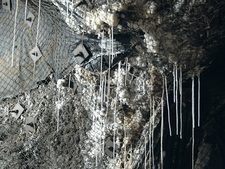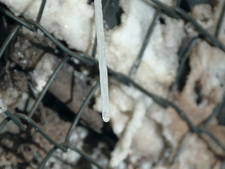Formation water in Konrad
A clay layer seals the repository from the groundwater. Existing waters are inclusions from the ore deposit’s time of origin.
The Konrad ore deposit had formed marine sedimentarily approximately 150 million years ago, i.e. it originated from a primeval ocean. When the geological layers deposited, part of this primeval ocean water was enclosed. As the rock of the future Konrad repository is capable of taking up small volumes of water, part of this fossil water (formation water) is correspondingly enclosed in fine pores and clefts in the rock.

![]() A wet place underground. The deep water originates from the time many million years ago when the geological layers deposited
A wet place underground. The deep water originates from the time many million years ago when the geological layers deposited
Emergence and volume
In the scope of mining measures, such as the driving of galleries underground, the rock is “injured” and sets the enclosed solution free. The “dewatering” of the rock occurs at swallow holes and wet places underground. Such places have only a limited contingency of formation water and therefore run dry entirely after some time.
In 2009 the inflow of saline solution amounted to approx. 6,000 cubic metres. That corresponds to an amount of approx. 16 cubic metres per day. Half of it originated from the inflow to the mine. The remaining 3,000 cubic metres originated from a certain geological layer near the surface, the hilssandstein, which shaft piping 2 breaks through to the south of the mine area.
The water is continuously monitored and collected underground in water tanks and so-called pump swamps (collecting points the water is pumped from). The miners use part of the water to fight the dust and to maintain the roads underground. The rest is taken above ground.

![]() On account of their high salt content the formation water forms stalactites
On account of their high salt content the formation water forms stalactites
No connection to the groundwater.
In the area of the Konrad repository there are no direct natural connections between aquifers and the deeper lying geological layers where one intends to store low-level and intermediate-level radioactive waste in future. Man-made connections resulting from earlier test drillings have been densely backfilled in the meantime. The two shaft pipes of the repository mine will be sealed as well after the operational time.
Significant difference compared with Asse
The area at the Konrad repository where low-level and intermediate-level radioactive waste will be stored in future does thus have no contact with surface water. This is the key difference to the Asse repository. The up to 400-m-thick surface layer of clay seals large areas of the Konrad repository and prevents near-surface water from flowing into the mine. As the geological barrier is intact and there are no water routes, the inflow of near-surface groundwater can be ruled out.
State of 2011.03.10

